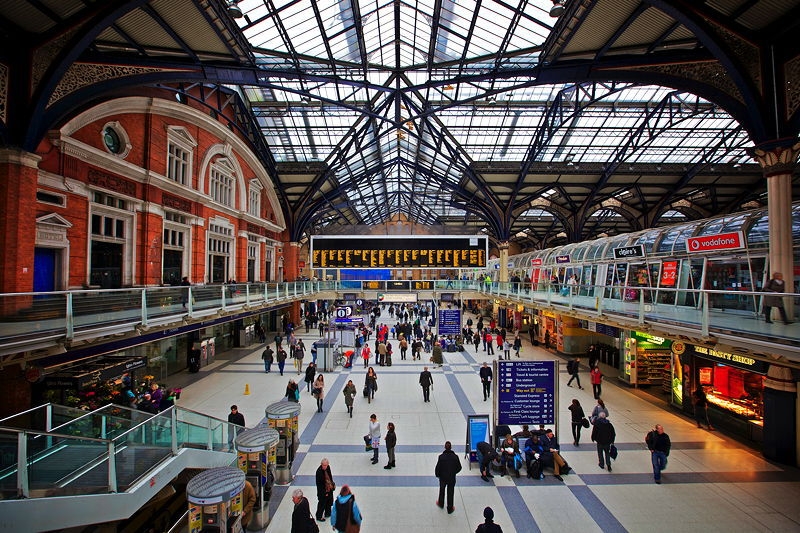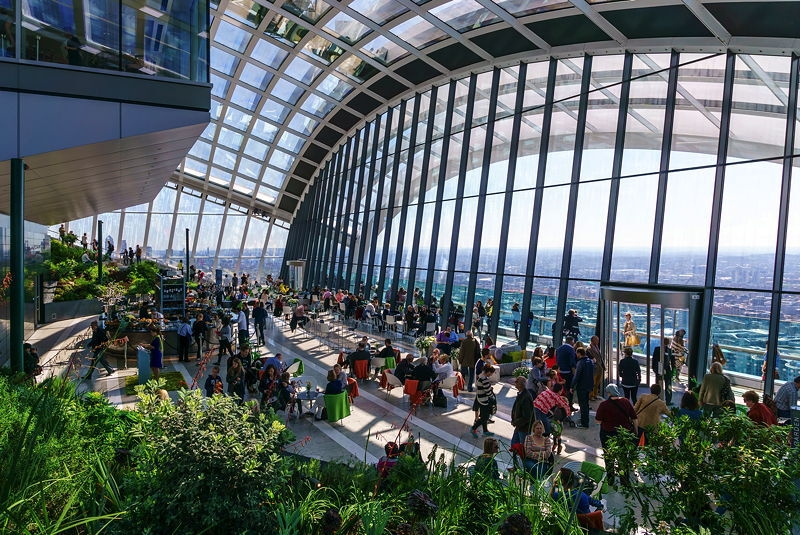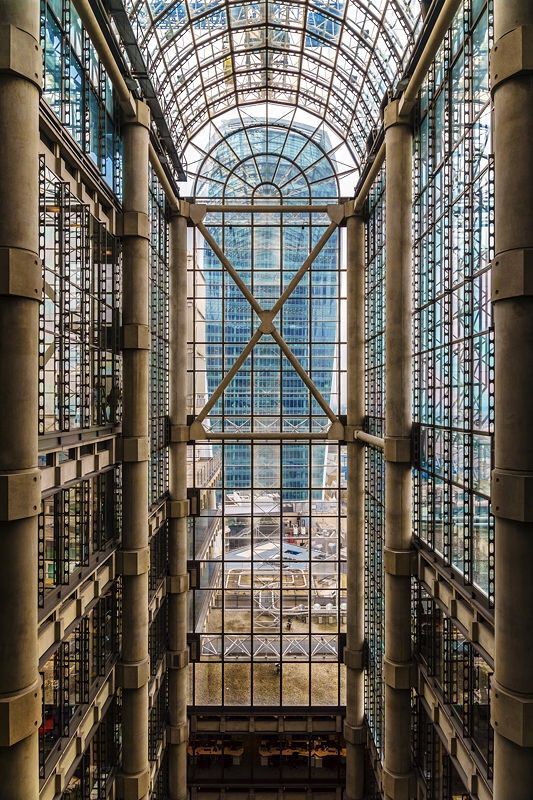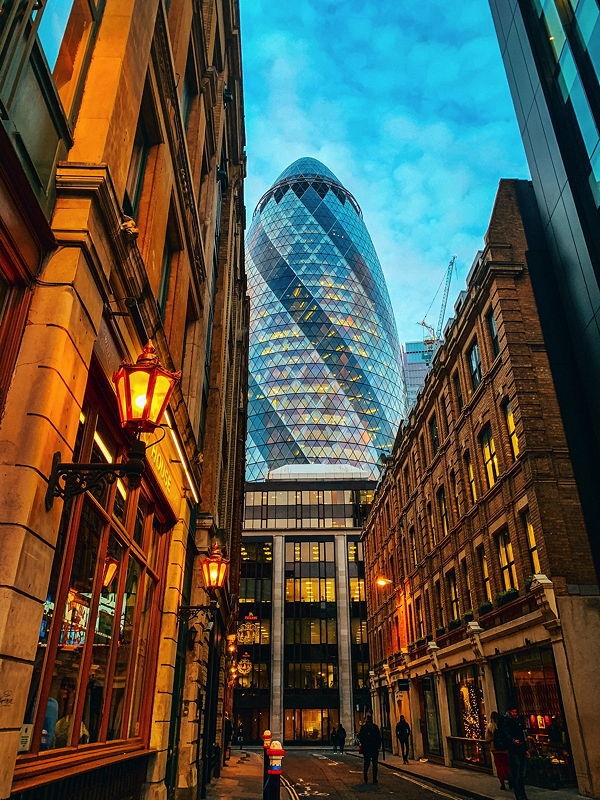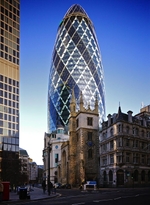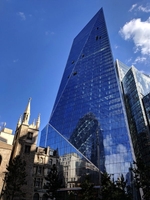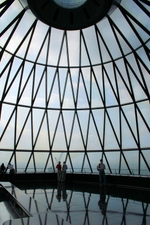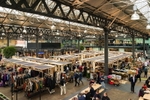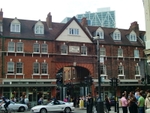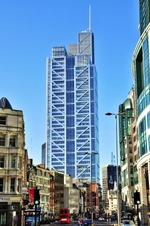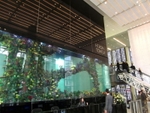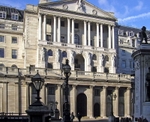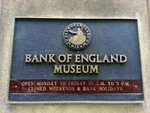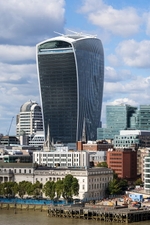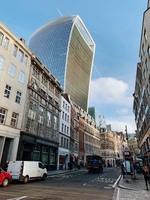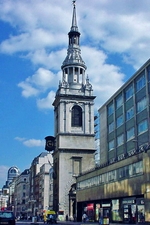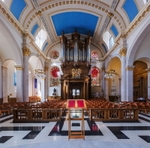1. The Gherkin and the Scalpel
Liverpool Street’s skyscrapers may not be the tallest in the world, but they are definitely the most stylish.
The Gherkin
Take 30 St Mary Axe, better known as the Gherkin. Clad entirely in glass, this Norman Foster designed building offers over 500,000 square feet of the trendiest and most environmentally friendly office space.
Opened in 2004, the Gherkin is 41 storeys and 180 metres tall, won the RIBA Sterling Prize for Architecture, and is worth about £600 million! Current tenants include Standard Life and Swiss Re.
But the building is not open to the public. You’ll have to score an invite if you want to visit its 40th-floor bar to soak up panoramic views of the city.
Or you can apply to join the exclusive private members’ club that operates from the 38th (which houses the club lounge) and 39th floors (where Searcys runs a members-only restaurant).
Annual fees are £750, with benefits including priority restaurant bookings 15% of restaurant food, and heavily discounted space hire.
The Scalpel
The Scalpel is the latest in brilliant skyscraper architecture. Completed in 2018, this Kohn Pedersen Fox designed building is 190 metres (or 38 storeys) tall. It is complete with 22 energy saving lifts, has 396 bike parking spaces and even has PV cells on the roof. It will largely be used for office space, though over 10,000 square feet have been allocated to restaurants, cafes and bars. A number of floors are already let to W. R. Berkley, Axis and Decus.
But The Scalpel is all about the knife-edged architecture that make it the sleekest and most fashionable office space in the city.
2. Spitalfields Market
Located just to the east of Liverpool Street station, Spitalfields Market is one of the finest surviving Victorian market halls in London.
Themed markets are held every day of the week in the central event space, surrounded by over 50 permanent shops.
Whether you are after a great breakfast, bargain from a market stall, or the latest fashion, Spitalfields is a must-see.
There has been a market at Spitalfieds since King Charles II granted John Balch a Royal Charter to hold a market on Spital Square in 1682. Thereafter the neighbourhood grew in popularity with weavers and artisans coming from the Irish and Polish communities in particular.
The 110 market stalls offer wares such as flowers, ladies fashion, posters and prints, art, records, jewellery, 5-minute massages, children’s toys and food and drink. General markets are held on Mondays, Tuesdays, Wednesdays and Sundays, with Antiques and Collectibles on Thursdays and Fashion on Fridays. A rolling programme of jewellery, vintage and record markets are held on Saturdays.
The surrounding shops include high-end fashion emporia (including Hackett, Barbour and Agnes B), arts and crafts (we recommend Lomography), interior design (such as ‘The Lollipop Shoppe’) and food and drink (with owner-operated outlets such as Sweet Basil and Café Caribbean and favourite chains including Wagamama, Fire and Stone and The Real Greek).
Continue past the market to take a look at the iconic Christ Church Spitalfields, built between 1714 and 1729 to a design by Nicholas Hawksmoor.
where? Spitalfields Market is found between Lamb and Brushfield Street, three minutes' walk to the north east of Liverpool Street underground and railway station.
when? 9am to 3pm, 7 days a week. Trading on the market stalls doesn't really get going until 11am.
£$€¥ Free.
3. The Heron Tower
The Heron Tower is the tallest of the lot: 230 metres (including its 28-metre mast), arranged over 46 floors.
Designed by Kohn Pedersen Fox, and completed in 2011, the Heron Tower (also known as 110 Bishopsgate or the Salesforce Tower) offers almost 50,000 square metres of fully-let office space.
The interior is famous for the 70,000 litre aquarium in reception. Tended by two full-time fish-keepers and a team of divers to keep the glass clean, the aquarium houses 60 varieties of fish in a sustainable ecosystem.
The Heron Tower also offers two well-regarded restaurants. SushiSamba is located on the 38-39th floors, and offers a mix of Japanese, Brazilian and Peruvian cuisine.
Starters are in the £10-20 range, with most main courses costing £20-30. For those with money to burn, why not try the 1 kilogram Kobe Beef option (price: £1,000!).
Duck & Waffle, found on the Heron Tower’s 40th storey, offers a “playful take” on British cuisine, with European influences. This translates as starters such as smoked eel, seared octopus, smoked mackerel and seared lambs breast (£10-15) and mains such roast chicken, Angus bone-in rib-eye, and miso glazed rabbit (c. £20).
when? The Duck & Waffle serves 24/7, with ‘late night’, breakfast and brunch menus.
4. The Bank of England Museum
Established in 1694, the Bank of England is the central bank of the United Kingdom, responsible for printing banknotes and setting interest rates.
Its history is told at the Bank of England Museum, a 1,000 square metre attraction five minutes from Bank station.
Exhibitions include:
- a reconstruction of an 18th century banking hall;
- the history of the banknote (which has recently been updated to co-incide with the Bank of England's launch of the new polymer £5 note);
- the modern economy (which teaches you about the Bank of England's Monetary Policy Committee and why they are so important);
- the ‘Gold Display’ (where visitors can handle a real 13 kilogram bar of bullion, worth about £400,000);
- an explanation as to why the Bank is often called the Old Lady of Threadneedle Street (after the ghost of Sarah Whitehead, said to haunt the Bank's garden); and
- a small area devoted to Kenneth Greene's Wild in the Willows, and its connection with the Bank of England!
This is a really child-friendly attraction. There are activity sheets for children of all ages, puzzles and challenges for them to complete (including opening a bank vault), and lots of other interactive displays. There are also lovely gold-bullion pins handed out to all those who complete their activity sheets!
Finally, don't forget to visit our page on other East London children's attractions.
where? Bartholomew Lane, London EC2R 8AH. Closest tube: Liverpool Street.
when? Monday to Fried, 10 and 5 pm. Last entry 4.30pm. Closed Weekends and Bank Holidays.
£$€¥ Free.
5. The Walkie-Talkie
The Walkie Talkie, or 20 Fenchurch Street to give it its official name, is the most accessible of the City of London's skyscrapers.
This 34-storey, 160-metre high Rafael Vinoly building was opened in 2014.
It is the fifth tallest building in the City, after Heron Tower (230 metres), 122 Leadenhall Street (aka the Cheesegrater, 225 metres), Tower 42 (183 metres) and the Gherkin (180 metres).
Its top three floors include a large sky-garden, together with a two restaurants (the Fenchurch Restaurant specialises in seafood and seasonal game, whilst the Darwin Brasserie dishes up classic British cuisine) and three bars (the Sky Pod and City Garden bars, known for their cocktails, and the Fenchurch Terrace, serving fine wines).
The Walkie-Talkie has not been an uncontroversial project. It won the Carbuncle Cup in 2015, awarded to the worst public building constructed in the previous year.
Its distinctive shape has created a concave mirror that focuses sunlight and has been responsible for melting nearby cars. And many have complained that the building has created a wind-tunnel at street level!
6. The Ned
The Ned is London's hottest new hotel.
Opened in 2017, the Ned has 252 bedrooms, ten restaurants, a range of bars, and a gym, spa and private members' club.
It is found in the former Midland Bank building, designed by Sir Edwin (or Ned) Lutyens in 1924, a stone's throw from Bank station in the heart of the city.
The Ned was put together by Soho House and a boutique hotel outfit at a reported cost of £200 million.
The design is 1920s and 1930s cool, with rooms ranging from Cosy (20-30 square metres) to 95 square metre family suites. The Ned's restaurants include Kaia (serving healthy Asia/Pacific food), Zobler's (a New York style Jewish deli), Cafe Sou (Parisian) and Cecconi's (an all-day Venetian brasserie).
This place has a definite wow-factor: turn up to the restaurants on a weekday evening and you will enter a buzzing, almost Vegas-style, amphitheatre filled with city-slickers eating, drinking and listening to live jazz.
Some of The Ned's best bits are reserved for members only. They include the Vault Bar, in the basement and occupying a former gold bullion safe (complete with 20 tonne safe door and 3000 original safety deposit boxes).
Rooms start at £300.
7. The Bow Bells
Founded in around 1080 as the London headquarters of the Archbishop of Canterbury, St Mary-le-Bow has had a fascinating history.
It survived three collapses before being completely destroyed by the 1666 Great Fire of London.
The church was freshly designed by Sir Christopher Wren, only to be destroyed again during the blitz on London during the Second World War.
St Mary-le-Bow is best known for its famous church bells. They are fabled to have been heard by Dick Whittington in 1392, persuading him to return to London where he would later become Lord Mayor. They are mentioned in the nursery rhyme 'Oranges and Lemons':
"I do not know, says the Great Bell of Bow".
In order to call yourself a true Cockney, you need to be born within earshot of the Bow Bells.
The Church's 40-metre tower houses 12 bells, the largest of which has a diameter of 61 inches. The chapel itself is light and airy. Visitors must not miss St Mary's crypt, which has been in continuing use since 1080.
These days the atmospheric crypt is home to an excellent restaurant: the Cafe Below. Serving British and European cuisine such as ginger and chilli lamb with cumin roast squash, yoghurt and mizuma (for £14), the Cafe Below gets great reviews. It also serves breakfast from 7.30 am and bakes fantastic bread.
8. Restaurants
Liverpool Street has a number of great restaurants, high end and cheap and cheerful, to cater for all tastes.
We love Ottolenghi Spitalfields, a chic Mediterranean / middle-eastern joint on Artillery Lane. Offering sit-down dining at tables or eating at bar (watching mixologists do their stuff), as well as a takeaway deli, you will be wowed by dishes like Dukkah crusted hake and Lamb Adana kebab with burnt aubergine.
We have mentioned The Ned and the restaurants at the Heron Tower already.
Other great options are The Ivy's City Branch (comfort food done well in a trendy setting), The Fish Market (with delightful dishes like Octopus carpaccio with olive tapenade and chilli) and the fun and good value Comptoir Libanais.
